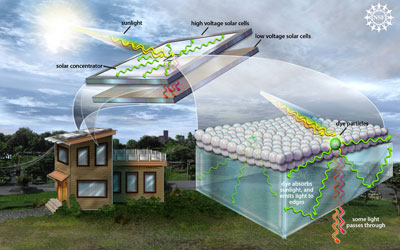|
Future PV Cells May Incorporate Luminescent Solar Concentrator Technology to Increase Efficiency
In this article, we'll find out what a luminescent solar concentrator (LSC) does, how it works and why it's more efficient and less expensive than older solar technologies. We'll also look at how LSCs might be used, when they could hit the commercial market.
A luminescent solar concentrator consists of a glass or plastic plate containing or coated with luminophores (dyes or phosphors) that absorb sunlight and emit light at longer wavelengths. A substantial part of the longer-wavelength light is trapped by total internal reflection and guided to the edges of the LSC plate, where it is absorbed by small-area PV cells. The idea of using LSCs already dates back 30 years (when they were built using primarily coated plastic) and much research has been carried out in this area. The main components in the traditional design are plastic / glass, dye molecules and solar cells. A variety of dye molecules are sprayed onto a sheet of plastic/glass. At the outer edges of the plastic are the solar cells. The combination of the plastic/glass and dyes works as a waveguide. A waveguide is any device that traps light and then moves those light waves along a path to a particular destination. 
In this case, when light hits the plastic/glass, the dyes absorb it. The sun's energy is thereby transferred to the dye, causing the electrons in those molecules to jump to a higher energy level. When the electrons fall back to a lower energy level, the dye molecules release that energy into the carrier sheet, where it gets stuck. In a process called total internal reflection, the light bounces around in the material, ultimately making its way to the outer surface. At the outer surface, the solar cells are waiting to absorb the light and generate electricity.
There are two primary advantages: 1) By concentrating the light to the edges … a much smaller amount of photovoltaic material is needed which helps to reduce overall cost of the panel. 2) A luminescent solar concentrator doesn't require a cooling system, and there are no moving parts, making it less expensive than a solar tracker.
While the light energy bounces around in the plastic, it sometimes gets reabsorbed into the dye molecules and ends up emitted as heat. This energy, then, never makes it to the solar cells. Also there is the issue that the effective life of the dyes are substantially less than that of the solar cells, required the units to be rebuilt to maintain their effectiveness over time.
The researchers at Massachusetts Institute of Technology (MIT) made a few primary changes to the traditional design to make it more efficient and even less expensive. They call it the luminescent solar concentrator (LSC). First, they traded in the plastic for glass. Glass is easier to manufacture, and it opens up some new possibilities in terms of applications -- more on this later. They also added a new element that eliminates the loss of energy to re-absorption. The newly redesigned luminescent solar concentrator is composed of a sheet of glass coated with particles of dye. It basically works like the old plastic version except for two additions. First, a type of aluminum called tris(8-hydroxyquinoline) is added to the mix of dye molecules. These aluminum molecules cause the dyes to emit light waves at a frequency the dyes can't absorb. In this way, no light is lost to re-absorption as it makes its way to the solar cells at the edges of the glass.
In this system, 10 times more of the sunlight that hits the panel is converted to electricity compared to a traditional solar panel [Source: Economist]. Each solar cell is exposed to much more sunlight, meaning fewer silicon cells are needed and the cost goes way down. How far down? Researchers aren't putting a dollar amount on the product, but it's sure to be cheaper than solar trackers. With increased efficiency, it'll also be able to generate more electricity per dollar than the solar panels you see on people's roofs now. Retrofitted onto current solar-panel systems, luminescent solar concentrators could increase efficiency by 50 percent [Source: ScienceDaily].
By far the most amazing aspect of the product, though, comes from the use of glass: By making windows out of these LSCs, the glass that lets sunlight into our homes and offices could also generate the power we need to run those spaces. We're not quite there yet, though. The biggest obstacle to getting these solar-power windows onto our homes is longevity. In fact, the LSC prototype only lasts about three months [Source: TreeHugger]. The MIT group is working to get the panel to maintain stability for the 10 or so years people expect these types of devices to last.
In summary, the prospects for LSCs are good. They can provide inexpensive PV energy and, because they consist of colored sheets of material, be attractive objects to integrate in built environments or consumer appliances. To generate solar energy with appreciable efficiency, suitable luminescent materials with low self-absorption should be developed, for example, rare-earth-containing line emitters. Applying wavelength-selective filters makes it possible to reach high concentration factors. Future work will be directed towards obtaining suitable luminescent materials and filters and combining them with appropriate PV cells into efficient LSCs. Best guess at this time: we can expect luminescent solar concentrators to be available for sale within three years [Source: MIT].
To read about the latest in luminescent solar collector research, read our article about Luminescent Solar Laser. Back from this page on Luminescent Solar Concentrator to our lead page on Solar Research
|


